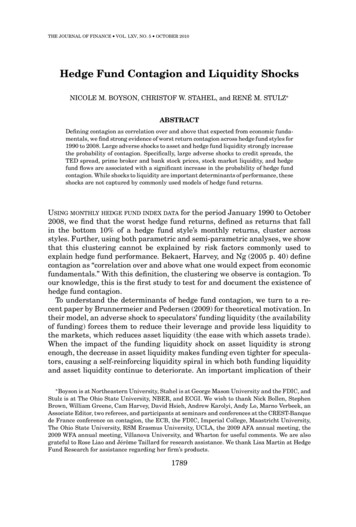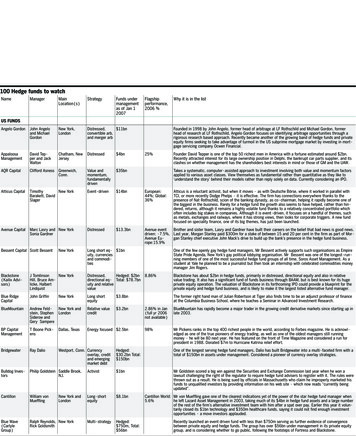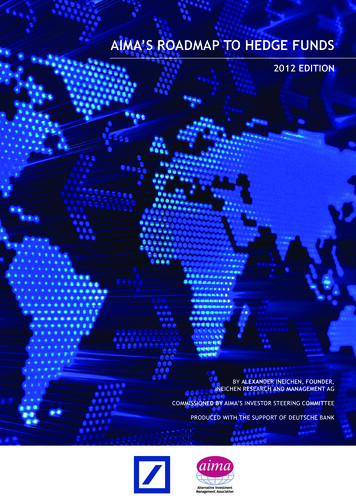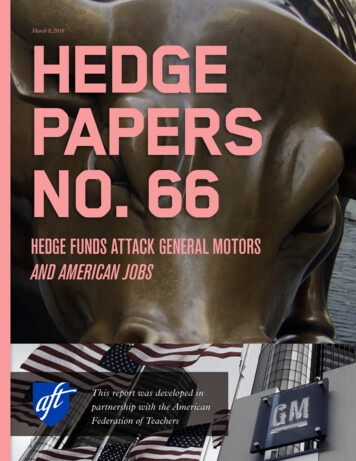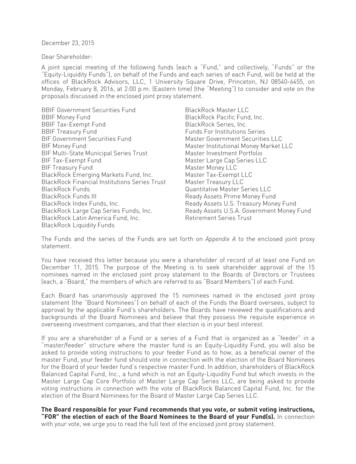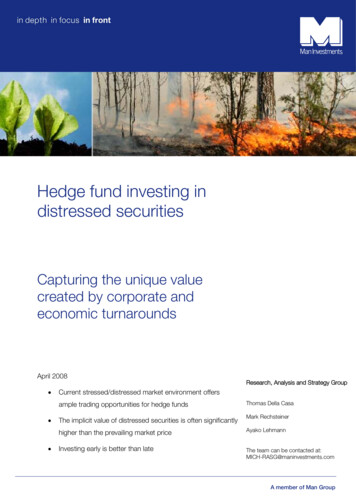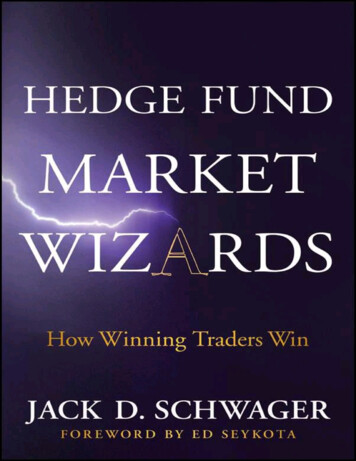
Transcription
ContentsForewordPrefaceAcknowledgmentsPart One: Macro MenChapter 1: Colm O’SheaAddendum: Ray Dalio’s Big Picture ViewChapter 2: Ray DalioChapter 3: Larry BenedictChapter 4: Scott RamseyChapter 5: Jaffray WoodriffPart Two: Multistrategy PlayersChapter 6: Edward ThorpChapter 7: Jamie MaiChapter 8: Michael PlattPart Three: Equity TradersChapter 9: Steve ClarkChapter 10: Martin TaylorChapter 11: Tom ClaugusChapter 12: Joe VidichChapter 13: Kevin DalyChapter 14: Jimmy BalodimasChapter 15: Joel Greenblatt
ConclusionEpilogueAppendix AAppendix BAbout the AuthorIndex
Other Books by Jack D. SchwagerA Complete Guide to the Futures Markets: Fundamental Analysis, Technical Analysis, Trading, Spreads, and OptionsGetting Started in Technical AnalysisMarket Wizards: Interviews with Top TradersThe New Market Wizards: Conversations with America’s Top TradersStock Market Wizards: Interviews with America’s Top Stock TradersSchwager on Futures: Fundamental AnalysisSchwager on Futures: Managed Trading Myths & TruthsSchwager on Futures: Technical AnalysisStudy Guide to Accompany Fundamental Analysis (with Steven C. Turner)Study Guide to Accompany Technical Analysis (with Thomas A. Bierovic and Steven C. Turner)
Copyright 2012 by Jack D. Schwager. All rights reserved.Published by John Wiley & Sons, Inc., Hoboken, New Jersey.Published simultaneously in Canada.No part of this publication may be reproduced, stored in a retrieval system, or transmitted in any form or by any means, electronic, mechanical,photocopying, recording, scanning, or otherwise, except as permitted under Section 107 or 108 of the 1976 United States Copyright Act, withouteither the prior written permission of the Publisher, or authorization through payment of the appropriate per-copy fee to the Copyright ClearanceCenter, Inc., 222 Rosewood Drive, Danvers, MA 01923, (978) 750-8400, fax (978) 646-8600, or on the Web at www.copyright.com. Requests tothe Publisher for permission should be addressed to the Permissions Department, John Wiley & Sons, Inc., 111 River Street, Hoboken, NJ 07030,(201) 748-6011, fax (201) 748-6008, or online at http://www.wiley.com/go/permissions.Limit of Liability/Disclaimer of Warranty: While the publisher and author have used their best efforts in preparing this book, they make norepresentations or warranties with respect to the accuracy or completeness of the contents of this book and specifically disclaim any impliedwarranties of merchantability or fitness for a particular purpose. No warranty may be created or extended by sales representatives or written salesmaterials. The advice and strategies contained herein may not be suitable for your situation. You should consult with a professional whereappropriate. Neither the publisher nor author shall be liable for any loss of profit or any other commercial damages, including but not limited tospecial, incidental, consequential, or other damages.For general information on our other products and services or for technical support, please contact our Customer Care Department within theUnited States at (800) 762-2974, outside the United States at (317) 572-3993 or fax (317) 572-4002.Wiley also publishes its books in a variety of electronic formats. Some content that appears in print may not be available in electronic books. Formore information about Wiley products, visit our web site at www.wiley.com.Library of Congress Cataloging-in-Publication DataSchwager, Jack D., 1948–Hedge fund market wizards : how winning traders win / Jack D. Schwager.p. cm.Includes index.ISBN 978-1-118-27304-3 (hardback)1. Floor traders (Finance). 2. Hedge funds. I. Title.HG4621.H27 2012332.64’524—dc232012004861
With love to my wife, Jo Ann, the best thing that ever happened to me (I know because she tells me so, and she has never been wrong)
Lara Logan: Do you feel the adrenaline at all?Alex Honnold: There is no adrenaline rush. . . . If I get a rush, it means that something has gone horribly wrong. . . . The whole thing should bepretty slow and controlled. . . .—Excerpt of 60 Minutes interview (October 10, 2011) with Alex Honnold, acknowledged to be the best free-soloing climber in the world, whoseextraordinary feats include the first free-solo climb up the northwest face of Half Dome, a 2,000-foot wall in Yosemite National ParkTo do my vacuum cleaner, I built 5,127 prototypes. That means I had 5,126 failures. But as I went through those failures, I made discoveries.—James Dyson
ForewordOnce upon a time, a drought comes over the land and the wheat crop fails. Naturally, the price of wheat goes up. Some people cut back and bakeless bread while others speculate and buy as much wheat as they can get and hoard it in hopes of higher prices to come.The king hears about all the speculation and high prices and promptly sends his soldiers from town to town to proclaim that speculation is now acrime against the state—and that severe punishment is to befall speculators.The new law, like oh so many laws against the free market, only compounds the problem. Soon, some towns have no wheat at all—while rumorhas it that others still have ample, even excess, supplies.The king keeps raising the penalty for speculation, while the price of wheat, if you can find any, keeps going higher and higher.One day, the court jester approaches the king and, in an entertaining sort of way, tells the king of a plan to end the famine—and to emerge as awise and gracious ruler.The next day, the soldiers again ride from town to town, this time to proclaim the end of all laws against speculation—and to suggest that eachtown prominently post the local price for wheat at its central marketplace.The towns take the suggestion and post the prices. At first, the prices are surprisingly high in some towns and surprisingly low in others. Duringthe next few days, the roads between the towns become virtual rivers of wheat as speculators rush to discount the spreads. By the end of the week,the price of wheat is mostly the same everywhere and everyone has enough to eat.The court jester, having a keen sense for his own survival, makes sure all the credit goes directly to the king.I like this story.The loose end, of course, is how the court jester happens to know so much about how markets work—and how he happens to know how toexpress what he knows in an effective way.While we may never know the answer for sure, my personal hunch is that the court jester makes frequent visits to the royal library and readsReminiscences of a Stock Operator by Edwin Lefèvre, The Crowd by Gustav LeBon, Extraordinary Popular Delusions and the Madness ofCrowds by Charles Mackay, and the entire Market Wizards series by Jack Schwager.Trading, it turns out, is the solution to most economic problems; free markets, sanctity of trading, and healthy economy are all ways to say thesame thing. In this sense, our traders are champions and the men and women in Jack Schwager’s books are our heroes.Schwager’s books define trading by vividly portraying traders. He finds the best examples, he makes them human and accessible, and he allowsthem to express, in their own ways, what they do and how they do it. He gives us a gut feel for the struggles, challenges, joys, and sorrows all ofthem face over their entire careers. We wind up knowing each of his subjects intimately—and also as a uniquely complete expression of repeatingthemes, such as: be humble; go with the flow; manage risk; do it your own way.Schwager’s books are essential reading for anyone who trades, wants to trade, or wants to pick a trader.I go back a ways with Jack. I recall meeting him while we were both starting out as traders, long on enthusiasm and short on experience. Over theyears, I watched him grow, mature, and develop his talent, evolving to become our Chronicler-General.Schwager’s contribution to the industry is enormous. His original Market Wizards inspired a whole new generation of traders, many of whomsubsequently appeared in The New Market Wizards, and then, in turn, in Stock Market Wizards. Jack’s Wizards series becomes the torch thattraders pass from one generation to the next. Now Hedge Fund Market Wizards extends, enhances, and perfects the tradition. Traders regularlyuse passages and chapters from Schwager’s books as a reference for their own methods and to guide their own trading. His work is aninseparable part of the consciousness and language of trading itself.Some 30 years ago, Jack reads Reminiscences of a Stock Operator and notices its meaningfulness and relevance, even 60 years after itspublication. He adopts that standard for his own writing.I notice that books that actually meet that standard tend to wind up in the libraries of traders and court jesters alike, on the same shelf withReminiscences, The Crowd, and Extraordinary Popular Delusions and the Madness of Crowds.That’s exactly where you find Jack’s books in my library.Ed SeykotaBastrop, TexasFebruary 25, 2012
PrefaceThis volume is part of my continuing effort to meet with exceptional traders to better understand the elements underlying their success and whatdifferentiates them from the multitude of pedestrian market participants. The traders interviewed range from the founder of the largest hedge fund inthe world, managing 120 billion in assets with 1,400 employees, to a manager running a solo operation with only 50 million in assets. Some ofthe managers trade from a long-term perspective, holding positions for many months and even years, while others focus on trading horizons asshort as a single day. Some managers utilize only fundamental data, others only technical input, and still others combine both. Some of themanagers have very high average returns with substantial volatility, while other managers have far more moderate returns, but with much lowervolatility.The one characteristic that all the managers share is that they have demonstrated an ability to generate superior return/risk performance.Because so much of what passes for high returns merely reflects a willingness to take more risk rather than being an indication of skill, I believe thatreturn/risk is a far more meaningful measure than return alone. In fact, the fixation of investors on return without the appropriate consideration of riskis one of the great investment mistakes—but that is a story for another book. One return/risk measure that I have found particularly useful is the Gainto Pain ratio—a statistic that is explained in Appendix A.There were three key criteria for selecting interviews to be included in this book:1. The managers had superior return/risk track records for significant length periods—usually (but not always) 10 or more years and oftenmuch longer.2. The managers were open enough to provide valuable advice about trading.3. The interviews provided sufficient color to allow for a readable chapter.A half dozen of the interviews I did for this volume were not used because they fell short in one or more of these categories.Over longer-term intervals (e.g., 10 years, 15 years), hedge funds consistently outperform equity indexes and mutual funds.1 The typical pattern isthat hedge funds, as a group, will have modestly higher returns, but far lower volatility and equity drawdowns. It is ironic that in terms of any type ofrisk measure, hedge funds, which are widely viewed as highly speculative, are actually much more conservative than traditional investments, suchas mutual funds. It is primarily as a consequence of lower risk that hedge funds tend to exhibit much better return/risk performance than mutualfunds or equity indexes. Moreover, with rare exception, the best managers are invariably found within the hedge fund world. This fact is notsurprising because one would expect the incentive fee structure of hedge funds to draw the best talent.When I conducted the interviews for my first two Market Wizard books (1988–1991), hedge funds were still a minor player in the world investmentscene.2 Based on estimates by Van Hedge Fund Advisors, total industry assets under management during that period were in the approximate 50 billion to 100 billion range. Since that time, however, hedge fund growth has exploded, expanding more than twentyfold, with the industrycurrently managing in excess of 2 trillion. The impact of hedge fund trading activity far exceeds its nominal size because hedge fund managerstrade far more actively than traditional fund managers. The enhanced role of hedge funds has itself influenced market behavior.With hedge funds accounting for a much larger percentage of trading activity, trading has become more difficult. In some strategies, the effectcan clearly be seen. For example, systematic trend-followers did enormously well in the 1970s and 1980s when they accounted for a minority offutures trading activity, but their return/risk performance declined dramatically in subsequent decades, as they became a larger and larger part ofthe pool. Too many big fish make it more difficult for other big fish to thrive.Even if one does not accept the argument that the greater role of hedge funds has made the game more difficult, at the very least, it has madethe game different. Markets change and good traders adapt. As hedge fund manager Colm O’Shea states in his interview, “Traders who aresuccessful over the long run adapt. If they do use rules, and you meet them 10 years later, they will have broken those rules. Why? Because theworld changed.” Part of that change has been brought about by the increasing prominence of hedge funds themselves.Not surprisingly, virtually all of the traders interviewed in this volume are hedge fund managers (or ex–hedge fund managers). The one exception,Jimmy Balodimas, a highly successful proprietary trader with First New York Securities, had to adapt to the presence of hedge funds. In hisinterview, he describes how hedge fund activity changed the nature of equity price movements and how he had to adjust his own approachaccordingly.Markets have changed in the generation since I wrote the first Market Wizards book, but in another sense, they have not. A bit of perspective isuseful. When I asked Ed Seykota in Market Wizards whether the increasing role of professionals had changed the markets (a shift that theintervening years have demonstrated was then only in its infancy), he replied, “No. The markets are the same now as they were 5 to 10 years agobecause they keep changing—just like they did then.”In many of the interviews, traders made reference to one or more of my earlier books. I did not include all such references, but I included morethan I was comfortable doing. I am quite cognizant how self-serving this may appear to be. My guideline whether to include such references was toask myself the following question: Would I include this comment if the reference were to another book, rather than my own? If the answer was yes, Iincluded it.Readers who are looking for some secret formula that will provide them with an easy way to beat the markets are looking in the wrong place.Readers who are seeking to improve their own trading abilities, however, should find much that is useful in the following interviews. I believe thetrading lessons and insights shared by the traders are timeless. I believe that although markets are always changing, because of constancies inhuman nature, in some sense, they are also always the same. I remember, when first reading Reminiscences of a Stock Operator by EdwinLefèvre nearly 30 years ago, being struck by how relevant the book remained more than 60 years after it was written. I do not mean or intend todraw any comparisons between this volume and Reminiscences, but merely to define the goal I had in mind in writing this book—that it still bemeaningful and useful to readers trading the market 60 years from now.1All the performance statements made in reference to hedge funds as an investment category implicitly assume hedge fund of funds data.Indexes based on fund of funds returns largely avoid the significant statistical biases inherent in hedge fund indexes that are based onindividual manager returns.2Market Wizards, New York Institute of Finance, 1989. New Market Wizards, New York, HarperBusiness, 1991.
AcknowledgmentsFirst and foremost, I would like to thank my son Zachary for being my sounding board for this book. He had three essential qualifications for fulfillingthis role: He understands the subject matter; he can write; and most importantly, he can be brutally honest in his opinions. His comments about onechapter: “Sorry, Dad, but I think you should pull it.” Although reluctant to see two weeks of work go to waste, on reflection, I realized he was right, andI did. Zachary provided many useful suggestions (besides “ax it”), most of which were incorporated. Whatever defects remain, I can assure thereader they would have been worse without Zachary’s assistance.Four of the interviews in this book were suggested and arranged through the help of others. In this regard, I am deeply grateful to the following,each of whom was the catalyst responsible for one of the interviews in this volume: John Apperson, Jayraj Chokshi, Esther Healer, and ZacharySchwager. I also want to acknowledge that Michael Lewis’s terrific book, The Big Short, was the source for one of the interview ideas for this book.I would also like to thank Jeff Feig for his efforts.Finally, I would like to thank the traders who agreed to participate in the interviews and share their insights, and without whom there would be nobook.
Part One
MACRO MEN
Chapter 1
Colm O’Shea
Knowing When It’s RainingWhen I asked Colm O’Shea to recall mistakes that were learning experiences, he struggled to come up with an example. At last, the best he wasable to do was describe a trade that was a missed profit opportunity. It is not that O’Shea doesn’t make mistakes. He makes lots of them. As hefreely acknowledges, he is wrong on at least 50 percent of his trades. However, he never lets a mistake get remotely close to the point where itwould provide a good story. Large trading losses are simply incompatible with his methodology.O’Shea is a global macro trader—a strategy style that seeks to profit from correctly anticipating directional trends in global currency, interestrate, equity and commodity markets. At surface consideration, a strategy that requires participating in directional moves in major global marketsmay not sound like it would be well suited to maintaining tightly constrained losses, but the way O’Shea trades, it is. O’Shea views his trading ideasas hypotheses. A market move counter to the expected direction is proof that his hypothesis for that trade is wrong, and O’Shea then has noreluctance in liquidating the position. O’Shea defines the price point that would invalidate his hypothesis before he places a trade. He sizes hisposition so that the loss from a move to that price level is limited to a small percentage of assets. Hence, the lack of any good war stories of tradesgone awry.O’Shea’s interest in politics came first, economics second, and markets third. His early teen years coincided with the advent of Thatcherism andthe national debate over reducing the government’s role in the economy—a conflict that sparked O’Shea’s interest in politics and soon aftereconomics. O’Shea educated himself so well in economics that he was able to land a job as an economist for a consulting firm before he beganuniversity. The firm had an abrupt opening for an economist position because of the unexpected departure of an employee. At one point in hisinterview for the position, he was asked to explain the seeming paradox of the Keynesian multiplier. The interviewer asked, “How does takingmoney from people by selling bonds and giving that same amount of money back to people through fiscal spending create stimulus?” O’Sheareplied, “That is a really good question. I never thought about it.” Apparently, the firm liked that he was willing to admit what he did not know ratherthan trying to bluff his way through, and he was hired.O’Shea had picked up a good working knowledge of econometrics through independent reading, so the firm made him the economist for theBelgian economy. He was sufficiently well prepared to be able to use the firm’s econometric models to derive forecasts. O’Shea, however, waskept behind closed doors. He was not allowed to speak to any clients. The firm couldn’t exactly acknowledge that a 19-year-old was generating theforecasts and writing the reports. But they were happy to let O’Shea do the whole task with just enough supervision to make sure he didn’t mess up.At the time, the general consensus among economists was that the outlook for Belgium was negative. But after he had gone through the data anddone his own modeling, O’Shea came to the conclusion that the growth outlook for Belgium was actually pretty good. He wanted to come up with aforecast that was at least 2 percent higher than the forecast of any other economist. “You can’t do that,” he was told. “This is not how things work.We will allow you to have one of the highest forecasts, and if growth is really strong as you expect, we will still be right by having a forecast near thehigh end of the range. There is nothing to be gained by having a forecast outside the range, in which case if you are wrong, we would lookridiculous.” As it turned out, O’Shea’s forecast turned out to be right, but no one cared.His one-year stint as an economist before he attended university taught O’Shea one important lesson: He did not want to be an economicconsultant. “As an economic consultant,” he says, “how you package your work is more important than what you have actually done. There ismassive herding in economic forecasting. By staying near the benchmark or the prevailing range, you get all the upside of being right without thedownside. Once I understood the rules of the game, I became quite cynical about it.”After graduating from Cambridge in 1992, O’Shea landed a job as a trader for Citigroup. He was profitable every year, and his trading line andresponsibilities steadily increased. By the time O’Shea left Citigroup in 2003 to become a portfolio manager for Soros’s Quantum Fund, he wastrading an exposure level equivalent to a multibillion-dollar hedge fund. After two successful years at Soros, O’Shea left to become a global macrostrategy manager for the multimanager fund at Balyasny, a portfolio that was to be the precursor for his own hedge fund, COMAC, formed two yearslater.O’Shea has never had a losing year. The majority of his track record, spanning his years at Citigroup and Soros, is not available for publicdisclosure, so no precise statements about performance can be made. The only portion of this track record that is available is for the period atBalyasny, which began in December 2004, and his current hedge fund portfolio, which launched in June 2006. For the combined period, as of endof 2011, the average annual compounded net return was 11.3 percent with an annualized volatility of 8.1 percent and a worst monthly loss of 3.7percent. If your first thought as you read this is “only 11.3 percent,” a digression into performance evaluation is necessary.Return is a function of both skill (in selecting, implementing, and liquidating trades) and the degree of risk taken. Doubling the risk will double thereturn. In this light, the true measure of performance is return/risk, not return. This performance evaluation perspective is especially true for globalmacro, a strategy in which only a fraction of assets under management are typically required to establish and maintain portfolio positions.1 Thus, ifdesired, a global macro manager could increase exposure by many multiples with existing assets under management (i.e., without any borrowing).The choice of exposure will drive the level of both returns and risk. O’Shea has chosen to run his fund at a relatively low risk level. Whethermeasured by volatility (8.2 percent), worst monthly loss (3.7 percent), or maximum drawdown (10.2 percent), his risk metrics are about half that ofthe average for global macro managers. If run at an exposure level more in line with the majority of global macro managers, or equivalently, at avolatility level equal to the S&P 500, the average annual compounded net return on O’Shea’s fund would have been about 23 percent. Alternatively,if O’Shea had still been managing the portfolio as a proprietary account, an account type in which exposure is run at a much higher level relative toassets, the returns would have been many times higher for the exact same trading results. These discrepancies disappear if performance ismeasured in return/risk terms, which is invariant to the exposure level. O’Shea’s Gain to Pain ratio (a return/risk measure detailed in Appendix A) isa strong 1.76.I interviewed O’Shea in London on the day of the royal wedding. Because of related street closures, we met at a club at which O’Shea was amember, instead of at his office. O’Shea explained that he had chosen to join this particular club because they had an informal dress code. Weconducted the interview in the club’s drawing room, a pleasant space, which fortunately was sparsely populated, presumably because most peoplewere watching the wedding. O’Shea spoke enthusiastically as he expressed his views on economics, markets, and trading. At one point in ourconversation, a man came over and asked O’Shea if he could speak more quietly as his voice was disrupting the tranquility of the room. O’Sheaapologized and subsequently dropped his voice level to library standards. Since I was recording the conversation, as I do for all interviews—I amsuch a poor note taker that I don’t even make the attempt—I became paranoid that the recorder might not clearly pick up the now softly speakingO’Shea. My concerns were heightened anytime there was an increase in background noise, which included other conversations, piped-in music,
and the occasional disruptive barking of some dogs one of the members had brought with him. I finally asked O’Shea to raise his voice to somecompromise level between his natural speech and the subdued tone he had assumed. The member with the barking dogs finally left, and as hepassed us, I was surprised to see—although I really shouldn’t have been—that it was the same man who had complained to O’Shea that he wasspeaking too loudly.When did you first become interested in markets?It was one of those incredible chance occurrences. When I was 17, I was backpacking across Europe. I was in Rome and had run out of booksto read. I went to a local open market where there was a book vendor, and, literally, the only book they had in English was Reminiscences of aStock Operator. It was an old, tattered copy. I still have it. It’s the only possession in the world that I care about. The book was amazing. Itbrought everything in my life together.What hooked you?What hooked me early about macro was . . .No, I meant what hooked you about the book? The book has nothing to do with macro.I disagree. It’s all there. It starts off with the protagonist just reading the tape, but that isn’t what he developed into. Everyone gives him tips, butthe character Mr. Partridge tells him all that matters, “It’s a bull market.”2That’s a fundamental macro person. Partridge teaches him that there is a much bigger picture. It’s not just random noise making the numbersgo up and down. There is something else going on that makes it a bull or bear market. As the book’s narrator goes through his career, hebecomes increasingly fundamental. He starts talking about demand and supply, which is what global macro is all about.People get all excited about the price movements, but they completely misunderstand that there is a bigger picture in which those pricemovements happen. Price movements only have meaning in the context of the fundamental landscape. To use a sailing analogy, the windmatters, but the tide matters, too. If you don’t know what the tide is, and you plan everything just based on the wind, you are going to end upcrashing into the rocks. That is how I see fundamentals and technicals. You need to pay attention to both to make sense of the picture.Reminiscences is a brilliant book about the journey. The narrator starts out with an interest in watching numbers go up and down. I started outwith an interest in politics and economics. But we both end up in a place that is not that far apart. You need to develop your own marketexperience. You are only going to fully understand what the traders in your books were saying after you have done it yourself. Then you realize,“Oh, that’s what they meant.” It seems really obvious. But before you experience it and learn it, it’s hard to understand.What was the next step in your journey to becoming a trader after reading Reminiscences?I went to Cambridge to study economics. I knew I wanted to study economics from the age of 12, well before my interest in markets. I wanted todo it because I loved economics, not because I thought that was a pathway to the markets. Too many people do things for other reasons.What did you learn in college about economics that was important?I was very lucky that I went to college when I did. If I went now, I think I would be really disappointed because the way economics is currentlytaught is terrible.Tell me what you mean by that.When I went to university, economics was taught more like philosophy than engineering. Since then, economics has become all aboutmathematical rigor and modeling. The thing about mathematical modeling is that in order to make problems tractable, you need to makeassumptions. Assumptions then become axiomatic for the entire subject—not because they are true, but because they are necessary to get asolution. So, it is easier to assume efficient markets because without that assumption, you can’t do the math. The problem is that marketsaren’t efficient, but that fact
Over longer-term intervals (e.g., 10 years, 15 years), hedge funds consistently outperform equity indexes and mutual funds.1 The typical pattern is that hedge funds, as a group, will have modestly higher returns, but far lower volatility and equity drawdowns. It is ironic that in terms of any type of risk me

